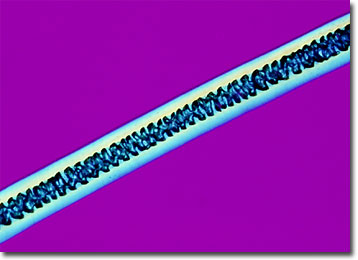Polarized Light Microscopy Digital Image Gallery
Opossum Hair
Native to the New World, there are more than 60 species of opossum that have been identified. Well known for “playing possum” when frightened, this instinctive response often spares the animals from attack by predators who believe they are already dead.

View a second image of Opossum Hair
The opossum is one of the only marsupials that is found naturally outside of the Australia-New Guinea region. Moreover, their populations remain strong despite the ongoing destruction of the wooded areas they typically inhabit. The success of the animals is generally attributed to their flexible eating habits as omnivores and their impressive rate of reproduction. Indeed, the gestation period of opossums is less than two weeks and there are typically about ten babies in a single litter. The young opossums of most species are born blind and furless, weighing only about two grams each. After birth, these tiny creatures must climb along the fur of the mother to reach her frontal pouch, in which they reside for several more weeks, feeding and continuing their development. Subsequently, they spend another few months carried upon the back of the mother, who feeds and protects them until they are mature enough to fend for themselves.
Though generally nocturnal, opossums vary somewhat in behavior, as well as in habitat and appearance. The species most familiar to those in North America is the Virginia, or common, opossum, which is the only species that lives at such latitudes. This animal is often about the size of a domestic cat, but has a long pointy nose, rounded ears, and a long prehensile tail that lacks fur. Though adaptable, the common opossum prefers wooded areas, often establishing its den in tree stumps or hollows. The yapok, or water opossum, however, which ranges from Mexico to Argentina, has evolved in such a way that it is best suited to a very different lifestyle than that of the common opossum. Its webbed toes, watertight pouch, and dense, oily pelt are ideal for the animal’s semi-aquatic existence.
